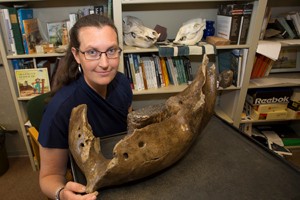
Mammoth and Mastodon Behavior Was Less Roam, More Stay at Home
Their scruffy beards weren't ironic, but there are reasons mammoths and mastodons could have been the hipsters of the Ice Age.
According to research from the University of Cincinnati, the famously fuzzy relatives of elephants liked living in Greater Cincinnati long before it was trendy at the end of the last ice age. A study led by Brooke Crowley, an assistant professor of geology and anthropology, shows the ancient proboscideans enjoyed the area so much
they likely were year-round residents and not nomadic migrants
as previously thought.
They even had their own preferred hangouts. Crowley's findings indicate each species kept to separate areas based on availability of favored foods here at the southern edge of the Last Glacial Maximum's major ice sheet.
"I suspect that this was a pretty nice place to live, relatively speaking," Crowley says. "Our data suggest that animals probably had what they needed to survive here year-round."
COULD THE PAST SAVE THE FUTURE?
Crowley's research with co-author and recent UC graduate Eric Baumann, "
Stable Isotopes Reveal Ecological Differences Among Now-Extinct Proboscideans from the Cincinnati Region, USA
," was recently
, an international academic research journal.

Brooke Crowley in the lab
Learning more about the different behaviors of these prehistoric creatures
could benefit their modern-day cousins, African and Asian elephants
. Both types are on
the World Wildlife Fund's endangered species list
. Studying how variable different types of elephants might have been in the past, Crowley says, might help ongoing efforts to protect these largest of land mammals from continued threats such as poaching and habitat destruction.
"There are regionally different stories going on," Crowley says. "There's not one overarching theme that we can say about a mammoth or a mastodon. And that's becoming more obvious in studies people are doing in different places. A mammoth in Florida did not behave the same as one in New York, Wyoming, California, Mexico or Ohio."
THE WISDOM IN TEETH
For their research, Crowley and Baumann looked to the wisdom in teeth specifically museum specimens of molars from four mastodons and eight mammoths from Southwestern Ohio and Northwestern Kentucky.
Much can be revealed by carefully drilling a tooth's surface
and analyzing the stable carbon, oxygen and strontium isotopic signatures in the powdered enamel.

Eric Baumann in the lab
Each element tells a different story. Carbon provides insight into an animal's diet, oxygen relates to overall climatic conditions of an animal's environment and strontium indicates how much an animal may have traveled at the time its tooth was forming.
"Strontium reflects the bedrock geology of a location," Crowley says. "So if a local animal grows its tooth and mineralizes it locally and dies locally, the strontium isotope ratio in its tooth will reflect the place where it lived and died. If an animal grows its tooth in one place and then moves elsewhere, the strontium in its tooth is going to reflect where it came from, not where it died."
Their analysis allowed them to determine several things:
- Mammoths ate more grasses and sedges than mastodons, which favored leaves from trees or shrubs.
- Strontium from all of the animals (except one mastodon) matched local water samples, meaning they likely were less mobile and migratory than previously thought.
- Differences in strontium and carbon between mammoths and mastodons suggest they didn't inhabit the same localities.
- Mammoths preferred to be closer to the retreating ice sheet where grasses were more abundant, whereas mastodons fed farther from the ice sheet in more forested habitat.
As a geologist, questioning the past is one of the most interesting and exciting things to do, says Baumann, an environmental geologist with a contractor for the U.S. Environmental Protection Agency. Based on our data, mammoths and mastodons seemed to have different diets and lived in different areas during their lives. This is important because it allows us to understand how species in the past lived and interacted. And the past is the key to the present.
Crowley of the
McMicken College of Arts and Sciences
plans further research into how strontium isotopes can be used to explore megafauna, including other projects dealing with mammoths and mastodons.
Related Stories
UC Journalism to host Hall of Fame, Young Alumni Awards
Event: April 24, 2025 6:00 PM
The College of Arts and Sciences’ journalism department will host the Hall of Fame and Young Alumni Awards to celebrate the achievements and accomplishments of its graduates. Induction into the UC Journalism Hall of Fame is a special honor reserved for UC alumni who have excelled in the profession of journalism and media, or individuals who have made a significant contribution to journalism at UC.
Bradford pear trees look pretty, smell awful. Why are they...
April 2, 2025
WLWT talks to UC biology Professor Theresa Culley about Ohio's ban on the sale or planting of nonnative and invasive pear trees. The trees are showing up in many parks and wild areas where they are crowding out native species.
Bird-safe glass added to UC building
April 2, 2025
UC biologist Ronald Canterbury tells Fox19 that bird-safe glass in buildings can save untold numbers of birds.
